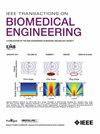Modeling the Mechanisms of Non-Neurogenic Dynamic Cerebral Autoregulation
IF 4.4
2区 医学
Q2 ENGINEERING, BIOMEDICAL
引用次数: 0
Abstract
非神经源性动态脑自动调节机制建模
目的:动态脑自动调节(Dynamic cerebral autoregulation, dCA)是指在动脉血压(ABP)变化的情况下维持脑血流量(CBF)接近恒定的稳态,但在各种脑血管疾病中会受到损害的一系列机制。目前,dCA的作用机制及其在不同生理条件下的影响尚不清楚。本研究的目的是解开dCA的肌源性和代谢反应的大小和时间尺度,以研究dCA受损时每种机制是如何受到影响的。方法:建立dCA的生理模型,其中肌源性和代谢反应均由增益和时间常数表示。模型参数在正碳酸、大腿袖带和高碳酸条件下进行优化。通过传递函数分析(TFA)对实验记录的ABP (Finapres)、末潮CO2 (capnograph)和CBF速度(双侧大脑中动脉经颅多普勒超声)的脉冲响应进行推导。结果:与正常碳酸血症相比,高碳酸血症的肌原性增益与时间常数之比明显更小(单因素和多因素TFA的p值< 0.001),代谢时间常数明显更大(单因素和多因素TFA的p值< 0.001)。结论:dCA损伤后,肌源性和代谢反应均受到影响,代谢反应减慢。意义:本研究有助于了解dCA的复杂性及其在不同生理条件下的影响。
本文章由计算机程序翻译,如有差异,请以英文原文为准。
求助全文
约1分钟内获得全文
求助全文
来源期刊

IEEE Transactions on Biomedical Engineering
工程技术-工程:生物医学
CiteScore
9.40
自引率
4.30%
发文量
880
审稿时长
2.5 months
期刊介绍:
IEEE Transactions on Biomedical Engineering contains basic and applied papers dealing with biomedical engineering. Papers range from engineering development in methods and techniques with biomedical applications to experimental and clinical investigations with engineering contributions.
 求助内容:
求助内容: 应助结果提醒方式:
应助结果提醒方式:


